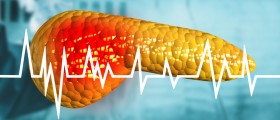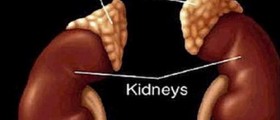
The pancreas is both endocrine and exocrine gland, located behind the stomach and in front of the spine. This organ looks like a 6 inches long pear and has three different parts, the head (the widest section), the body (the middle part) and the tail (the narrow end of the pancreas).
Endocrine and Exocrine Pancreas
Since it has two functions, endocrine and exocrine, it is normal to expect that this organ will also have two separate types of cells as well. These are endocrine and exocrine pancreas cells.
Endocrine pancreas is responsible for production of hormones and their various functions in the body. These cells form small islets (clusters) in the pancreas and are commonly called islets of Langerhans or just islet cells.
Exocrine pancreas cells produce digestive enzymes, which enhance digestion in the small intestine. The structure of the pancreas is like a bunch of ducts and sacs at the end of these ducts, lined with exocrine pancreas cells.
Functional Tumors of Endocrine Pancreas
Both of these cells may change malignantly. Islet cell tumors are rare and they could be either functional or nonfunctional, depending whether they produce any hormones and cause associated signs and symptoms.
Functional tumors release different hormones like insulin, gastrin or glucagon and although tumors are usually benign in nature, hormones can cause some problems to patients. Depending on produced hormones, doctors differentiate gastrinoma, glucagonoma, insulinoma or some other tumors, such as VIPomas and Somatostatinomas (these produce VIP, vasoactive intestinal peptide or Somatostatin).
Patients suffering from too much gastrin may experience symptoms such as recurrent stomach ulcers, abdominal and back pain, diarrhea and gastroesophageal reflux. Overproduction of glucagon by some benign tumor is associated with skin rash on the face, legs and stomach, diarrhea, weight loss, sore tongue or sores on corners of the mouth, hyperglycemia (high blood sugar) and blood clots in the lungs. Too much insulin in someone’s body due to functional endocrine tumor of pancreas is known to lead to fast heart beat and low blood sugar. Vipomas can provoke watery diarrhea, dehydration, abdominal cramps, unexplained weight loss and hypokalemia. Somatostatinoma tumors cause diarrhea, steatorrhea, gallstones, weight loss, jaundice or high blood sugar.
Non-Functional Tumors of Endocrine Pancreas
Non-functional tumors commonly do not cause any symptoms although the majority of them is malignant in nature. The growing tumor and its spread are responsible for all health problems these patients might experience.
These tumors may be growing inside the body for a long period of time, not provoking any symptoms. But, once they reach certain size or start spreading and affecting different parts of the body, they can lead to digestion problems, diarrhea and jaundice (yellowing of the eyes and skin), while some patients may suffer from back and abdominal pain and eventually feel lumps in the abdomen.
















Your thoughts on this
Loading...